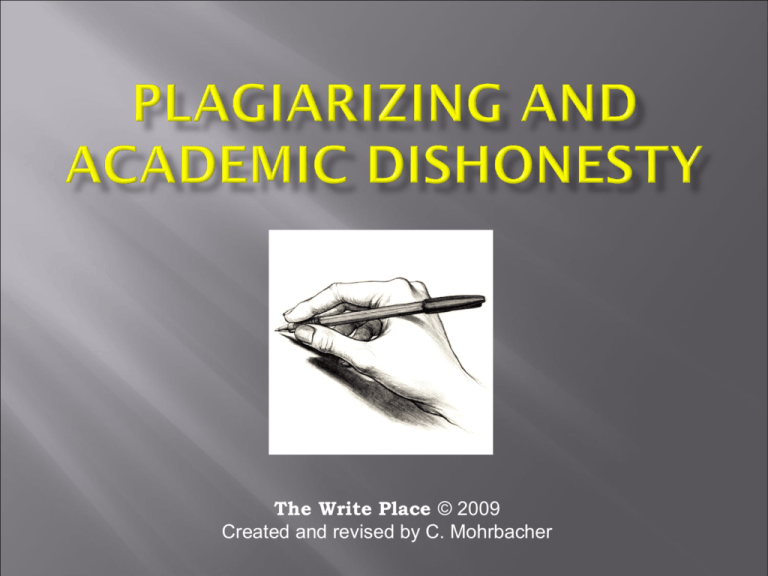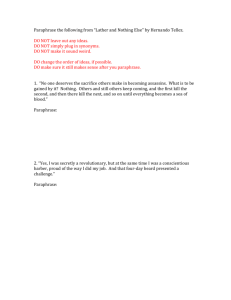
The Write Place © 2009
Created and revised by C. Mohrbacher
“Plagiarism includes, but is not limited to,
1.
the use by paraphrase or direct quotation, the
published or unpublished work of another person
without full and clear acknowledgment;
2.
unacknowledged use of materials prepared by
another person or agency engaged in selling or
otherwise providing term papers or other academic
materials;
3.
and commercialization, sale, or distribution of class
notes without the instructors' permission”
(“St. Cloud State Student Handbook” online)
Cite all sources in-text and on a reference list, works cited page, or
in a bibliography.
Cite all sources of paraphrases, quotations, summaries, statistics,
visual images, charts, graphs, maps and every time you use an
author’s ideas, or spoken or written words.
Cite every time you use what is NOT common knowledge.
Common knowledge is information that is widely known within a
society or an intellectual community; therefore, if you include
common knowledge in your paper, you do not need to cite where
you found that information. Example: the date that Reagan was
shot, the dates of wars, OR a reference to a theory or information
that is commonly understood among your audience.
Use quotation marks anytime you use an author’s
unique wording—even if it is only a few words.
Example: Lawrence Lessig said that the government showed no
real interest in changing the law and that the Senate “gave up”
on debating the statute (Vaidhyanathan 23).
Quote accurately.
When you paraphrase, make sure you do not
misrepresent an author’s ideas.
Material might be common knowledge if one of the
following is true:
The same information is undocumented in at least 5 sources
It is information that your audience probably already knows
Anyone could find the same information in general
reference sources (e.g. dictionary, encyclopedia)
It is a date of a birth, death, war, important event, etc..
1.
2.
3.
4.
5.
6.
7.
The Titanic was a ship that sank on its maiden voyage after it hit an
iceberg.
The Titanic had three propellers that were driven by two four-cylinder,
triple-expansion, inverted reciprocating steam engines and one lowpressure Parsons turbine.
Mahatma Gandhi was a non-violent leader in India’s move to
independence from Great Britain.
Gandhi was assassinated on January 30, 1948.
In 1888 Gandhi set sail for England, where he had decided to pursue a
degree in law. Though his elders objected, Gandhi could not be prevented
from leaving; and it is said that his mother, a devout woman, made him
promise that he would keep away from wine, women, and meat during
his stay abroad. Gandhi left behind his son Harilal, then a few months
old.
Barack Obama is married to Michele and they have two daughters.
Obama struggled with the absence of his father, who he saw only once
more after his parents divorced, in a brief 1971 visit.
Use handbooks for guidance. Use citation
format name (e.g., MLA or APA) as search
term to find handbook in library or online.
See Literacy Education Online (LEO) link on
Write Place website for documentation help
and format guides.
See Purdue OWL for MLA and APA Guides.
Writings, both published and unpublished
Books, magazines, journals, newspapers, handouts, etc
Material borrowed from a friend’s paper or other source not
published.
Classroom materials, lectures, information received from
conversation with professor
Opinions and judgments that you have borrowed from someone
else
Statistics and other facts that are not widely known
Widely known: John Lennon died in New York City in front of
the Dakota Apartment Building on December 8, 1980. He was
killed by Mark David Chapman.
Not widely known: Of the students who graduate from college
this year, 57% will fail to find a job in their fields. Another 10%
will be unemployed for 12-18 months (Jones 143).
Images and graphics
Personal communications
Works of art
Drawings
Charts, graphes, and tables
Photographs
Maps
Advertisements
Interviews (in person, by email, by phone, by letter)
Letters
Any electronic communication (Instant messaging, emailing, texting, etc.)
Public electronic communication
Facebook, instant messaging, chat rooms, My Space, email ,etc.
Television and radio broadcasts
Motion pictures and videos
Sound recordings
Web sites
Online discussion groups
Definition: Restating, “in your own words the
written or spoken words of someone else”
(Troyka 169)
Keeps your paper in your own style
Shows you understand the information
Many professors go by the 10% rule.
Say what the original says but no more.
Do not use the same words
Do not distort source’s meaning.
Paraphrase should be about as long as the original.
The sentence structure should NOT mirror the original.
Include citation for every paraphrase!
Original:
Unacceptable Paraphrase #1
•
The basic definition of science is that it is a productive method of research, not
a list of enticing conclusions (456).
Acceptable Paraphrase #1
“ Science, in its most fundamental definition, is a fruitful mode of inquiry, not a
list of enticing conclusions” (Gould 456).
Gould says that the basic definition of science is that it is a productive method of
research, “not a list of enticing conclusions” (456).
Acceptable Paraphrase #2
Science does not simply offer interesting conclusions; instead, it should be defined as
a productive form of research (Gould 456).
Read the original text.
Put original aside.
Write original’s ideas in your own words,
without looking at the original.
Compare the two for “borrowed” words or
incorrectly stated ideas or emphasis.
Revise.
Compare again.
Insert in-text citation.
“About Gandhi.” GhandiServ.org. 5 Feb., 2009. http://www.gandhiserve.org/
about_gandhi.html.
“Barack Obama Biography.” Bio.True Story. 2 Feb., 2010. http://www.biography.
com/articles/Barack-Obama-12782369.
Encyclopedia Titanica. 5 Feb, 2009. http://www.encyclopedia-titanica.org/
Glenn, Cheryl and Loretta Gray. The Writer’s Harbrace Handbook, 2nd ed. Boston:
Thomson-Wadsworth, 2007
Gould, Stephen Jay. “Sex Drugs, Disasters, and the Extinction of Dinosaurs.” 75
Readings Plus, 7th ed. Eds. Santi V. Buscemi and Charlotte Smith. Madison:
McGraw Hill, 2004. 456-463.
Hairston, Maxine, John Ruszkiewicz, and Christy Friend. The Scott Foresman
Handbook for Writers, 7th ed. Upper Saddle River: Pearson/Prentice Hall, 2004.
Oxford English Dictionary. Online. 12 October, 2005. http://oed.com/.
Rosen, Leonard J. and Laurence Behrens. The Allyn & Bacon Handbook, 2nd ed.
Boston: Allyn & Bacon, 1994.
“St. Cloud State Student Handbook” Online. St. Cloud State. 12 Oct. 2005.
http://www.stcloudstate.edu/studenthandbook/code/ conduct.asp
Vaidhyanathan, Siva. “Between Pragmatics and Anarchism.” Free Culture and the
Digital Library: Symposium Proceedings 2005. Emory University. Atlanta:
MetaScholar Initiative, 2005.
Thank you




